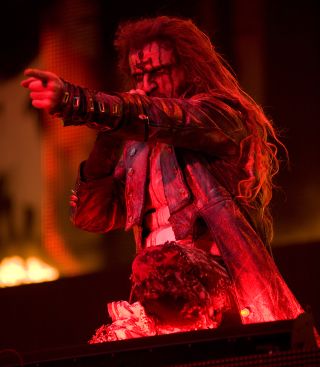The aftermath of the 80s goth explosion was, in a word, fragmented. Just as that shadowy form emerged from the post-punk milieu of the late 70s to varied result, the spiritual heirs to the throne of Bauhaus, The Mission, or indeed the Nephilim were as inexorably linked to other startling developments as they were to that undeniable triumvirate of romance, melancholy, and the macabre. And, just as with other genres, the prismatic effect of the 90s gave rise to a legion of groups who – if not goth per se – were unimpeachably gothic in both aesthetic and mood, and they would speak the languages first uttered by Numan and Iommi. It was the 1990s, and goth’s universal influence was finally taking shape.
By 1989, a slew of bands that incorporated gothic elements were racing toward the mainstream without ever being subsumed within the genre. Nine Inch Nails’ 1989 magnum opus Pretty Hate Machine, a cannon blast of industrial-strength wrath and pioneering sounds, would go on to achieve platinum status, but more importantly set the stage for a flood of sympathetic acts who would supply the soundtrack to that most angst-ridden of decades. Ministry, whose evolution from new wave dance pioneers to full-fledged, fire-breathing industrial banshees would reach their apex in 1992 when Jesus Built My Hotrod – a collaboration with alt-rock superhero Gibby Haynes of the Butthole Surfers – would commandeer the airwaves and MTV which, at the time, still held sway on the opinions of music fans. Even their side-project Revolting Cocks, with their outrageously raunchy rendition of Rod Stewart’s Do Ya Think I’m Sexy, was finding traction.

It paved the way for the artists like White Zombie, whose La Sexorcisto debut would be released by major-label magnate Geffen in March of 1992. Its off-kilter but infectious take on industrial caught the imagination of a generation of fans of heavy music who would revel in their dance-sensible grooves and B-horror aesthetic.
Simultaneously, off in the far reaches of Brooklyn, New York, another gothic storm was brewing, and it blew the doors off the record industry. To explain it, you need look no further than the mind of Pete Steele, who in 1989 had formed Type O Negative from the ashes of Carnivore. Owing equally to the music of Sabbath and The Beatles, it was only Steele’s humour dark, self-effacing, venomously sardonic, utterly joyless and above all funny as fuck – that would give the so-called Four Dicks from Brooklyn their unique allure. Sure, it was heavy, but amid the lusciously crafted riffs and synth-heavy despondence, there was a pop-loving catchiness there that would make their 1993 Bloody Kisses release a game-changing masterpiece. From the gargantuan, gothic epic of Christian Woman to the goth-mocking malice of Black No. 1 – an ode to the raven-haired women that served as Pete Steel’s muse – it would go on to achieve gold and then platinum certification, and cement Roadrunner Records as one of the most influential labels of its day.
But it was in 1994 that the real crossover began, and it wasn’t down to any single band. On May 13, Miramax would release The Crow, based on 80s comics guru James O’Barr’s fictional, alive-after-death avenger. Starring Brandon Lee, who would die from a freak accident on the set, the film would gross $50m, but that wasn’t its real achievement. With a soundtrack that ranged from likes of The Cure to the Violent Femmes to the darker, seedier sounds of industrial mavens Machines Of Loving Grace and indeed Nine Inch Nails potent cover of Joy Divisions’ Dead Souls, it codified and cemented goth’s blossoming influence while bringing it to the mainstream.

Meanwhile, across the Atlantic, another movement would leave its mark on almost every metal band that’s come since. It was the Peaceville (records) three: Paradise Lost, Anathema, and My Dying Bride – all British, all doom-laden, and all undeniably metal – who had grown to produce a mood that was wholly unique and wholeheartedly without comparison. From My Dying Bride’s landmark 1995 The Angel And the Dark River, with its orchestrated gloom, to the utterly stark, gloriously heavy, and arguable mastery of Paradise Lost’s 1995 Draconian Times, to Anathema’s prog-friendly The Silent Enigma, there was a gloriously fruitful time for fans of such darkened sensibilities. And then the apprentice to Trent Reznor started making some noise.
Marilyn Manson was already a household name among fans of heavy music by the time 1994’s ghoulish Portrait Of An American Family appeared (only to be overshadowed by Nine Inch Nail’s staggeringly dark 1994 heroin diary, The Downward Spiral). But it wouldn’t be long before Brian Warner’s alter ego would become the basis of morally panicked American mainstream and, in the UK, the subject of limitless bemusement and fandom. And with 1996’s incomparably dark and pop-sensible Antichrist Superstar, Manson would become a god. Replete with fetish-gear, wall-to-wall singles, and video-director Floria Sigismondi creating breathtakingly twisted and iconic videos for The Beautiful People and Torniquet, goth’s mutant heirs were as much about visual impact and multimedia as they were an addictive brew of rock, metal, industrial, and – dare we say it – dance.

Nowhere would that be more apparent than with what was perhaps the greatest achievement of mainstream penetration: the inclusion of a Coil remix of Nine Inch Nails’ Closer, from the Downward Spiral album on the grotesque opening credits to Brat Pitt/Morgan Freeman vehicle Seven. It was a perfection of sound and vision – an ideal marriage of grim visuals and soul-stirring melancholy. Goth’s next generation had arrived, but already the seeds for the next wave had been planted. Deep in the bowels of Helsinki, Ville Hermanni Valo was coming of age and – with a band signet so masterfully crafted and ubiquitously recognised as to rival Maiden’s Eddie – was about to become goth’s next superstar. 1997’s Greatest Love Songs Vol. 666 was just a herald of the sonic perfection that was to come with 1999’s Razorblade Romance. Owing everything to the UK’s Unholy Trinity, to Sabbath, to Type O, and indeed to 80s precedents that laid the foundation for the 90’s explosion of gothic sounds, Valo would move goth into its next great age with a sly grin and a sound that rested as much on unbeatable pop-sensibility as it did a knowing tip of the hat to his forbears.
Along with female-fronted Italians Lacuna Coil, chart-busting icons My Chemical Romance, and even Evanescence, whose saccharine vision would be rapturously received, thereby sealing goth’s fate as an ultimately mainstream proposition 30 years after its inception, Valo was the living embodiment of goth’s darkened ethos. Inside the hearts of countless music fans the world over, though, the legacy of goth’s timeless, monumental progenitors would beat on.
A Secret History Of Goth by the Claytown Troupe


